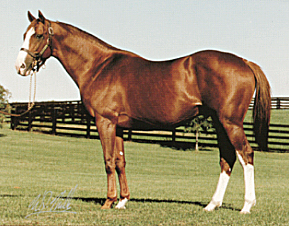 The 139th running of the Kentucky Derby is just days away and prep races for the big event, including the Arkansas Derby on April 10, have been analyzed down to minute details.
The 139th running of the Kentucky Derby is just days away and prep races for the big event, including the Arkansas Derby on April 10, have been analyzed down to minute details.
If Line of David, long-shot winner of this year’s Arkansas Derby, were to win the Kentucky Derby, he would be only the third horse to win both races. Smarty Jones accomplished the feat in 2004 and Sunny’s Halo (pictured) in 1983. It was Sunny’s Halo who first put Oaklawn on the map as a prep venue for the “Run for the Roses.”
Bred in Ontario, by a retired Toronto stockbroker out of his only mare, Sunny’s Halo was named champion 2-year-old colt in Canada. But he came to the Kentucky Derby with just two starts at three (he also won Oaklawn’s Rebel Stakes, as did Smarty Jones), at the time, the lightest 3-year-old campaign of any Derby winner since Jet Pilot in 1947.
He was sent off in the 1983 Kentucky Derby as the second choice in a field of 20, under Eddie Delahoussaye, the previous year’s winner on Gato Del Sol. Never more than a length off of a slow pace, Sunny’s Halo took the lead in the turn and drew off to win by two lengths.
Contending with a nasty skin rash up to the day of the race, Sunny’s Halo was the odds-on favorite in the Preakness, but finished sixth to Deputed Testamony on a sloppy track. Later in the season he placed second and third, respectively, in the G3 Volante Handicap and the G1 Whitney Stakes, then won the Invitational Super Derby at Louisiana Downs.
With a career record of nine wins in 20 starts, three second-place and two third-place finishes, and $1.25 million, Sunny’s Halo was syndicated following his Super Derby win and stood the early part of his stud career at Domino Stud, then Walmac International in Kentucky. He later became the all-time leading sire of Thoroughbreds in Texas and died in 2003 at Double S Thoroughbred Farm, Tyler, TX. He is buried at the Kentucky Derby Museum at Churchill Downs.
Several years ago, I talked with Sunny’s Halo’s trainer, David Cross Jr., about the flashy chestnut’s career. It was Cross who advised David Foster to breed his mare Mostly Sunny to Halo.
Sunny’s Halo as a yearling:
He showed so much even as a yearling. He just had everything going for him. He was like a kid that if you had him in the school room, he’d be the last one to walk out.
Sunny’s Halo in the saddling paddock on Kentucky Derby Day:
In those days, it was a small indoor paddock with hardly enough room for ten horses. They asked me if I’d take the horse out of the stall because there were so many horse in there and he was acting so well.
So we put him in the paddock and he was looking, but it was like he was looking right through you. I’d heard the old-timers talking about it when I was a kid – the look of eagles. They’re looking at you, but they’re looking right on through you like you’re just not there.
I was never as confident in my life as I was that day. He would have gone through a brick wall that day and that was all there was to it. I’d never seen anything like that or haven’t since. You have to be in the presence of it to understand.
Sunny’s Halo in the Preakness:
He broke out in a rash after the Derby. We had vets from all over the country and nobody could put their finger on it. I came within one inch of scratching him that day. I’d brought a vet out from New York and he said to go ahead and run him. We had a syndication going for $15 million provided he run in the Preakness.
He probably would have still gotten by that day, but he was knocked right to his knees coming out of the gate and that finished him, making up all that ground.
Sunny Halo’s running style:
You could set the horse anywhere you wanted him. He had a lot of natural speed. You could set him up close to the pace and you could call on this horse again, if you pushed that other button.
Sunny Halo’s breeding:
He was owned by a very small breeder up in Canada – a man with one mare. The horse didn’t come out of a big farm and Kentucky never really acknowledged him.
